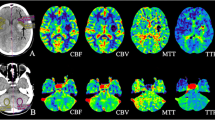Abstract
Various observations on the cerebellar vasoreactivity in crossed cerebellar diaschisis (CCD) have previously been reported. The purpose of this study is to clarify the difference between oxygen-15 H2O positon emission tomographic (PET) and technetium-99m hexamethylpropylene amine oxime (HMPAO) single-photon emission tomograph (SPET) findings in CCD and to evaluate the effect of the absolute values of the cerebellar blood flow as measured by15O-H2O PET on the99mTc-HMPAO SPET findings. The subjects comprised 15 patients with a supratentorial infarct and CCD. The cerebellar blood flow increased by about 40% at 5 and 20 min after acetazolamide i.v. on both the CCD and the non-CCD side, as measured by 150-1120 PET. The percentage differences in cerebellar blood flow between the CCD and the non-CCD side were −22.3%±5.7% in the resting state, −19.6%±6.4% at 5 min after acetazolamide i.v. and 21.5%±6.7% at 20 min after acetazolamide i.v., as measured by15O-H2O PET, while they were −10.6%±5.5% in the resting state and −5.6%±5.1% at 5 min after acetazolamide i.v., as measured by99mTc-HMPAO SPET. After Lassen's linearization correction, the latter two measurements were −16.2%±7.7% and −9.6%±8.9%, respectively. The effect of acetazolamide did not differ between the CCD and the non-CCD side in15O–H2O PET, while a greater response on the CCD side was observed in99mTc-HMPAO SPET, even after Lassen's linearization correction. It is concluded that acetazolamide HMPAO SPET may overestimate the cerebellar vascular response on the CCD side (or underestimate it on the non-CCD side).
Similar content being viewed by others
References
Baron JC, Bousser MG, Comar D, Castaigne P. “Crossed cerebellar diaschisis” in human supratentorial brain infarction [abstract].Ann Neurol 1980; 8: 128.
Pantano P., Baron JO, Samson Y, Bousser MG, Derouesne C, Comar D. Crossed cerebellar diaschisis: further studies.Brain 1986;109:677–694.
Pedersen E. Effect of acetazolamide on cerebral blood flow in subacute and chronic cerebrovascular disease.Stroke 1987; 18:887–891.
Chollet F, Celsis P, Clanet M, Chaumeil BG, Rascol A, Vergnes JPM. SPELT study of cerebral blood flow reactivity after acetazolamide in patients with transient ischemic attacks.Stroke 1989; 20: 458–464.
Lassen NA, Anderson AR, Friberg L, Paulsen OB. The retention of [Tc-99m]-d,l-HM-PAO in the human brain after intracarotid bolus injection: a kinetic analysis.J Cereb Blood Flow Metab 1988; 8: s13-s22.
Ishii K, Kanno I, Uemura K, Hatazawa J, Okudera T, Inugami A, Ogawa T, Fujita H, Shimosegawa E. Comparison of carbon dioxide responsiveness of cerebellar blood flow between affected and unaffected sides with crossed cerebellar diaschisis.Stroke 1994; 25: 826–830.
Huang SC. Quantitative measurement of local cerebral blood flow in humans by positron emission tomography and15O-water.J Cereb Blood Flow Metab 1983; 3: 141–153.
Iida H, Kanno I, Miura S, Murakami M, Takahashi K, Uemura K. Error analysis of a quantitative cerebral blood flow measurement using H2 15O autoradiography and positron emission tomography, with respect to the dispersion of the input function.J Cereb Blood Flow Metab 1986; 6: 536–545.
Matsuda H, Higashi S, Ash IN, Eftekhari M, Esmaili J, Seki H, Tsuji S, Oba H, Imai K, Terada H, Sumiya H, Hisada K. Evaluation of cerebral collateral circulation by technetium-99m HM-PAO brain SPELT during Matas test: report of three cases.J Nucl Med 1988; 29: 1724–1729.
Patronas NJ, Di Chiro D, Smith BH, De La Paz R, Brooks RA, Milan H, Kornblith PL, Bairamian D, Mansi L. Depressed cerebellar glucose metabolism in supratentorial tumors.Brain Res 1984; 291: 93–101.
Pappata S, Dinh ST, Baron C, Cambon H, Syrota A. Remote metabolic effects of cerebrovascular lesions: magnetic resonance and positron tomography imaging.Neuroradiology 1987; 29: 1–6.
Yamauchi H, Fukuyama H, Kimura J. Hemodynamic and metabolic changes in crossed cerebellar hypoperfusion.Stroke 1992; 23: 855–860.
Yamauchi H, Fukuyama H, Kimura J, Ishikawa M, Kikuchi H. Crossed cerebellar hypoperfusion indicates the degree of uncoupling between blood flow and metabolism in major cerebral arterial occlusion.Stroke 1994; 25: 1945–1951.
Bogsrud TV, Rootwelt K, Russell D, Nyberg-Hansen R. Acetazolamide effect on cerebellar blood flow in crossed cerebral-cerebellar diaschisis.Stroke 1990; 21: 52–55.
Sakashita Y, Matsuda H, Kakuda K, Takamori M. Hypoperfusion and vasoreactivity in the thalamus and cerebellum after stroke.Stroke 1993; 24: 84–87.
Matsuda H, Tsuji S, Sumiya H, Hogashi S, Kinuya K, Tonami N, Hisada K, Yamashita J. Acetazolamide effect on vascular response in areas with diaschisis as measured by99mTc-HMPAO brain SPECT.Clin Nucl Med 1992; 17: 581–586.
Terada H, Gomi T, Sasaki K, Murakami S, Sato S, Nagamoto M, Kuwajima A, Hiramatsu Y, Iwabuchi S, Samejima H, Yoshii N. Acetazolamide effect on vascular response in crossed cerebellar diaschisis as measured by 99mTc-HMPAO SPECT.Jpn J Nucl Med 1993; 30: 1075–1080.
Gotoh F, Meyer JS, Tomita M. Carbonic anhydrase inhibition and cerebral venous blood gases and ions in man. Arch Intern Med 1966; 117: 39–46.
Vorstrup S, Henriksen L, Paulson OB. Effect of acetazolamide on cerebral blood flow and cerebral metabolic rate for oxygen. J Clin Invest 1984; 74: 1634–1639.
Kuwabara Y, Ichiya Y, Sasaki M, Yoshida T, Masuda K. Time dependency of the acetazolamide effect on cerebral hemodynamics in occlusive cerebral arteries. Early steal phenomenon demonstrated by15O-H2O PET.Stroke 1995; 26: 1825–1829.
Murase K, Tanada S, Fujita H, Sakaki S, Hamamoto K. Kinetic behavior of technetium-99m-HMPAO in the human brain and quantification of cerebral blood flow using dynamic SPECT.J Nucl Med 1992; 33: 135–143.
Hayashida K, Nishimura T, Imakita S, Uehara T. Validation to eliminate vascular activity on 99Tcm-HMPAO brain SPELT for regional cerebral blood flow (rCBF) determination.Nucl Med Commun 1991; 12: 545–550.
Neirinckx RD, Bruke JF, Harrison RC, Forster AM, Anderson AR, Lassen NA. The retention mechanism of technetium-99m-HMPAO: intracellular reaction with glutamate.J Cereb Blood Flow Metab 1988; 8: s4-s12.
Anderson AR, Friberg H, Knudsen KBM, Barry DI, Paulson OB, Schmidt JF, Lassen NA, Neirinckx RD. Extraction of [99mTc]-d,l-HMPAO across the blood brain barrier.J Cereb Blood Flow Metabol 1988; 8: s44-s51.
Author information
Authors and Affiliations
Rights and permissions
About this article
Cite this article
Kuwabara, Y., Ichiya, Y., Sasaki, M. et al. Cerebellar vascular response to acetazolamide in crossed cerebellar diaschisis: a comparison of99mTc-HMPAO single-photon emission tomography with15O-H2O positron emission tomography. Eur J Nucl Med 23, 683–689 (1996). https://doi.org/10.1007/BF00834531
Received:
Revised:
Issue Date:
DOI: https://doi.org/10.1007/BF00834531




